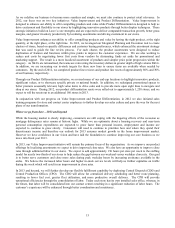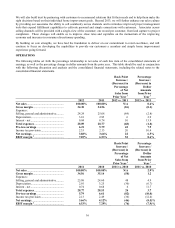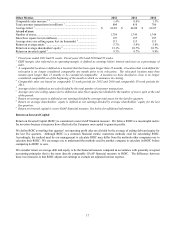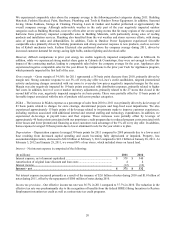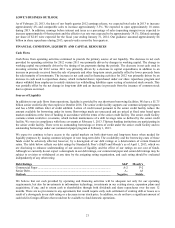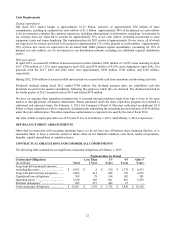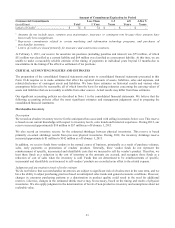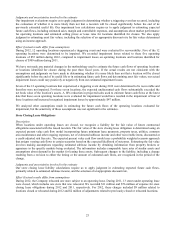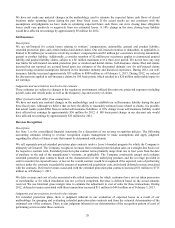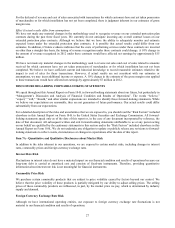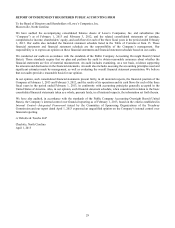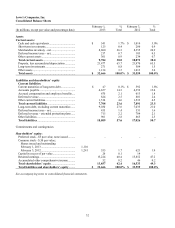Lowe's 2012 Annual Report Download - page 37
Download and view the complete annual report
Please find page 37 of the 2012 Lowe's annual report below. You can navigate through the pages in the report by either clicking on the pages listed below, or by using the keyword search tool below to find specific information within the annual report.
23
Amount of Commitment Expiration by Period
Commercial Commitments
(in millions) Total
Less Than
1 Year
1-3
Years
4-5
Years
After 5
Years
Letters of Credit 3 ...................................... $ 74 $ 74 $ - $ - $ -
1 Amounts do not include taxes, common area maintenance, insurance or contingent rent because these amounts have
historically been insignificant.
2 Represents commitments related to certain marketing and information technology programs, and purchases of
merchandise inventory.
3 Letters of credit are issued primarily for insurance and construction contracts.
At February 1, 2013, our reserve for uncertain tax positions (including penalties and interest) was $75 million, of which
$11 million was classified as a current liability and $64 million was classified as a noncurrent liability. At this time, we are
unable to make a reasonably reliable estimate of the timing of payments in individual years beyond 12 months due to
uncertainties in the timing of the effective settlement of tax positions.
CRITICAL ACCOUNTING POLICIES AND ESTIMATES
The preparation of the consolidated financial statements and notes to consolidated financial statements presented in this
Form 10-K requires us to make estimates that affect the reported amounts of assets, liabilities, sales and expenses, and
related disclosures of contingent assets and liabilities. We base these estimates on historical results and various other
assumptions believed to be reasonable, all of which form the basis for making estimates concerning the carrying values of
assets and liabilities that are not readily available from other sources. Actual results may differ from these estimates.
Our significant accounting policies are described in Note 1 to the consolidated financial statements. We believe that the
following accounting policies affect the most significant estimates and management judgments used in preparing the
consolidated financial statements.
Merchandise Inventory
Description
We record an obsolete inventory reserve for the anticipated loss associated with selling inventories below cost. This reserve
is based on our current knowledge with respect to inventory levels, sales trends and historical experience. During 2012, our
reserve increased approximately $10 million to $57 million as of February 1, 2013.
We also record an inventory reserve for the estimated shrinkage between physical inventories. This reserve is based
primarily on actual shrinkage results from previous physical inventories. During 2012, the inventory shrinkage reserve
increased approximately $1 million to $142 million as of February 1, 2013.
In addition, we receive funds from vendors in the normal course of business, principally as a result of purchase volumes,
sales, early payments or promotions of vendors’ products. Generally, these vendor funds do not represent the
reimbursement of specific, incremental and identifiable costs that we incurred to sell the vendor’s product. Therefore, we
treat these funds as a reduction in the cost of inventory as the amounts are accrued, and recognize these funds as a
reduction of cost of sales when the inventory is sold. Funds that are determined to be reimbursements of specific,
incremental and identifiable costs incurred to sell vendors’ products are recorded as an offset to the related expense.
Judgments and uncertainties involved in the estimate
We do not believe that our merchandise inventories are subject to significant risk of obsolescence in the near term, and we
have the ability to adjust purchasing practices based on anticipated sales trends and general economic conditions. However,
changes in consumer purchasing patterns or a deterioration in product quality could result in the need for additional
reserves. Likewise, changes in the estimated shrink reserve may be necessary, based on the timing and results of physical
inventories. We also apply judgment in the determination of levels of non-productive inventory and assumptions about net
realizable value.




